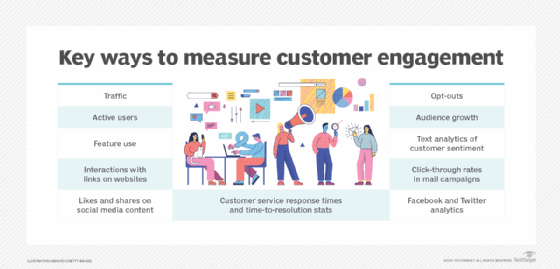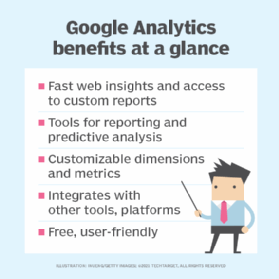|
Published: Apr 10, 2024 What is Google Analytics?Google Analytics is a web analytics service that provides numerous analytical tools useful for insights on website performance and marketing campaigns. Google Analytics is a web analytics service that provides statistics and basic analytical tools for search engine optimization and marketing purposes. The service is part of the Google Marketing Platform and is available for free to anyone with a Google account, regardless of whether they are working with enterprises or small businesses. Google Analytics is used to track website performance and collect visitor insights. It can help organizations determine top sources of user traffic, gauge the success of their marketing activities and campaigns, track goal completions (such as purchases, or adding products to carts), discover patterns and trends in user engagement, and obtain other visitor information such as demographics. Small and medium-sized retail websites often use Google Analytics to obtain and analyze various customer behavior analytics, which yield insight that can be the basis to improve marketing campaigns, drive website traffic and better retain visitors. Google Analytics (also known simply as Analytics) provides a range of analytics tools that enable companies to capture customer insights across devices and platforms. By understanding how customers interact with the company's sites and apps throughout their lifecycle, the company's Google Analytics users can better understand the customer journey, identify opportunities for improving customer experiences and improve marketing ROI. Google Analytics is easy to use. Besides powerful analytics capabilities, it includes built-in automation, provides a broad range of reporting options and can be integrated with other tools to become a single-measurement source of truth for customer data and insights. It also supports custom data analyses to fit the needs of different businesses. A business is on the path to a competitive advantage if it can analyze the broad span of customer journey touchpoints. How does Google Analytics work?To use Google Analytics, users must first create an Analytics account. This is different from a Google (Gmail) account. Having the latter does not automatically provide access to the former. A separate, one-time registration process is required. For Google Analytics to work on the business user's website (meaning, to capture and display useful analytics), the user must add a small piece of measurement code to each page on their site. This tracking code will collect pseudonymous information such as the following: Google Analytics will not collect data for any page lacking the tracking code. All collected data is aggregated and stored in a database. It is also organized and processed. Google Analytics creates reports that can help users better understand their customers and marketing results. Once processed data is stored in a database, it cannot be modified, so it's important for users to be careful about excluding data. These exclusions usually happen when users (mistakenly) assume they won't need some types of data for analysis and, on that basis, add filters to exclude it from analysis in Google Analytics. Google Analytics acquires user data from each website visitor through page tags. A JavaScript page tag, inserted into the code of each page, helps generate data such as the number of users, bounce rates, average session duration, sessions by channel, pageviews, goal completions and more. The page tag functions as a web bug or web beacon to gather visitor information. Because it relies on cookies, the system can't collect data for users who have disabled them. Google Analytics featuresGoogle Analytics includes numerous features that help users do more with customer data: Reporting in Google AnalyticsGoogle Analytics provides many types of reports, including the following:
Depending on their specific analysis or decision-making requirements, businesses can also use Google Analytics with Analytics 360 to get continuous intraday data, create separate data views for different countries or product lines, and see global metrics. In the Google Analytics dashboard, users can save profiles for multiple websites and see details for default categories or select custom metrics to display for each site. Available categories for tracking include content overview, keywords, referring sites, visitors overview, map overlay and traffic sources overview. The dashboard can be viewed on the Google Analytics site and is available through a widget or a plugin for embedding into other sites. Customized Google Analytics dashboards are also available from independent vendors. Important Google Analytics metricsA metric is a standard of quantitative measurement. Google Analytics supports up to 200 different metrics to measure how websites are performing. Here are some of the most popular metrics: Users. A unique or new visitor to the website. Bounce rate. The percentage of visitors who viewed only a single page. These visitors only triggered a single request to the Google Analytics server. Sessions. The group of visitor interactions that happen in a 30-minute window of activity. Average session duration. How long on average each visitor stays on the site. Percentage of new sessions. The percentage of website visits that are first-time visits. Pages per session. The average number of pageviews per each session. Goal completions. The number of times visitors complete a specified, desirable action, called a conversion. Pageviews. Total number of pages viewed. Metrics vs. dimensionsGoogle Analytics reports consist of dimensions and metrics. Understanding the difference between them is critical for proper interpretation of reports. Dimensions. These are qualitative attributes or labels used to describe and organize data. If the average session length is measured across several different regions, the dimensions would be "Region." "Average session length," which is a quantitative measurement, is an example of a metric. Dimensions can be customized in Google Analytics. Examples of common dimensions include the following: Language. Browser type. City and country. Models of devices. User age group. Metrics. These are quantitative measurements of a single type of data. Examples of metrics include average session lengths, pageviews, pages per session and average time on site. Metrics are used to compare measurements across different dimensions.
Here are the main benefits of Google Analytics: One of the limitations of Google Analytics is its reliance on data sampling techniques. In addition, data quality can be compromised by users who block Google Analytics cookies, certain browser extensions, ad filtering programs and privacy networks. The General Data Protection Regulation (GDPR), among other recent rules, has expanded the privacy rights of users. User acquisition data vs. user behavior dataGoogle Analytics can provide businesses with multiple types of data for marketing purposes. User acquisition data provides insight into how customers are arriving at a website. Customers may come from a variety of channels, such as paid search engine results, unpaid (organic) search engine results, social media links or directly typing in the URL. Understanding user acquisition data is critical for maximizing website traffic. User behavior data shows what customers are doing on the website and how they are engaging with the site. This includes how long they spend on each page, how many pages they visit, and if they engage with videos and graphics. This data can facilitate discussion of new or revised web layouts that better connect visitors with the content they are looking for, leading to a better user experience. User experiences optimized according to user behavior data are more likely to create sales and conversions. Google Analytics 4Google Analytics 4 (GA4) is the most recent version of the service, released in October 2020. Unlike the previous version (known as Universal Analytics or UA), GA4 uses an event-based data model, meaning it tracks each user interaction as an individual event. It also facilitates holistic data collection across multiple devices and platforms. GA4 shifts from reliance on third-party cookies toward the use of machine learning for better data accuracy. GA4 uses machine learning to generate predictive insights from data. Its AI capabilities also enable behavioral and conversion modeling. Other key features in Google Analytics 4 include the following: Deeper integration with Google Ads. Customer-centric measurement and measurements across the entire customer lifecycle. Data controls to simplify data collection, retention and use. Stronger data privacy (because the default IP anonymization feature in GA4 means Google will not store users' IP addresses). Google Analytics integrationsGoogle Analytics works with other Google solutions and partner products to help users improve marketing processes and performance. For example, Google Analytics can be connected to Google Ads so data from Google Ads will also be visible in Google Analytics (along with website and app performance data). Similarly, data from Display & Video 360 can be viewed in Google Analytics to help with automated bidding and create new audiences, as can data from the Google Search Console. The latter connection is helpful to identify the search queries driving users to a website and to assess the relationship between organic search performance and on-site action. Google Analytics data can seamlessly connect with other data sets to support business analysis and decision-making. It also comes with a built-in connection to BigQuery, Google Cloud's enterprise data warehouse, for seamless insight generation and data analysis. Google Analytics also integrates with third-party tools like Salesforce Marketing Cloud (SFMC). Users can view Google Analytics data in the SFMC reporting UI to better understand campaign performance (e.g., email marketing campaigns) and identify improvement areas for future campaigns. Customer data and behavior analytics from tools like Google Analytics can give content managers insight into the kind of content site visitors want. Explore ways analytics can improve organizations' content strategies. Continue Reading About Google Analytics
Related Terms
What is a self-organizing network (SON) and do you need one?
A self-organizing network (SON) is an intelligent infrastructure designed to simplify and accelerate the planning, configuration,...
See complete definition
What is an entity relationship diagram (ERD)?
An entity relationship diagram (ERD), also known as an entity relationship model, is a graphical representation that depicts ...
See complete definition
What is data analytics (DA)?
Data analytics (DA) is the process of examining data sets to find trends and draw conclusions about the information they contain.
See complete definition
|


